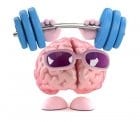A new study published in Current Biology states that exercise may enhance the plasticity of the adult brain.
Alessandro Sale, of the National Research Council’s Neuroscience Institute, previously conducted research that showed rats running on a wheel exhibited elevated levels of plasticity in the visual cortex and improved recovery from amblyopia when compared with sedentary animals.
Building on that, Sale and Claudia Lunghi, of the Univ. of Pisa, wanted to see if the phenomenon carried over to humans.
Brain plasticity is often greatest during early life. According to the Univ. of Washington, “At birth, each neuron in the cerebral cortex has approximately 2,500 synapses. By the time an infant is two or three years old, the number of synapses is approximately 15,000 synapses per neuron. This amount is about twice that of the average adult brain.”
Using 20 adults, Sale and Lunghi employed binocular rivalry to measure the residual plastic potential of the adult visual cortex. When one eyes is covered for a short period of time, the closed eye strengthens as the brain attempts to compensate for the lack of vision. The resulting imbalance is a measure of the brain’s visual plasticity.
In their experiment, Sale and Lunghi outfitted adults with an eyepatch and had them watch a movie. One group remained sitting in a chair while watching the movie, while the other group exercised for 10 min intervals on a stationary bike.
“We found that if, during the two hours of eye patching, the subject intermittently cycles, the perceptual effect of eye patching on binocular rivalry is stronger compared to a condition in which, during the two hours of patching, the subject watches a movie while sitting on a chair,” the researchers said. “That is, after physical activity, the eye that was patched is strongly potentiated, indicating increased levels of brain plasticity.”
Though more research is needed, the team believes an inhibitory neurotransmitter called GABA decreases during exercise, allowing the brain to become more responsive.
Further, the research could help treat adults with amblyopia. Amblyopia, or lazy eye, can be remedied during early age with vision therapy. As brain plasticity decreases with age, treating amblyopia becomes more difficult.
“Our study suggests that physical activity, which is also beneficial for the general health of the patient, could be used to increase the efficiency of the treatment in adult patients,” said Lunghi. “So, if you have a lazy eye, don’t be lazy yourself.”


